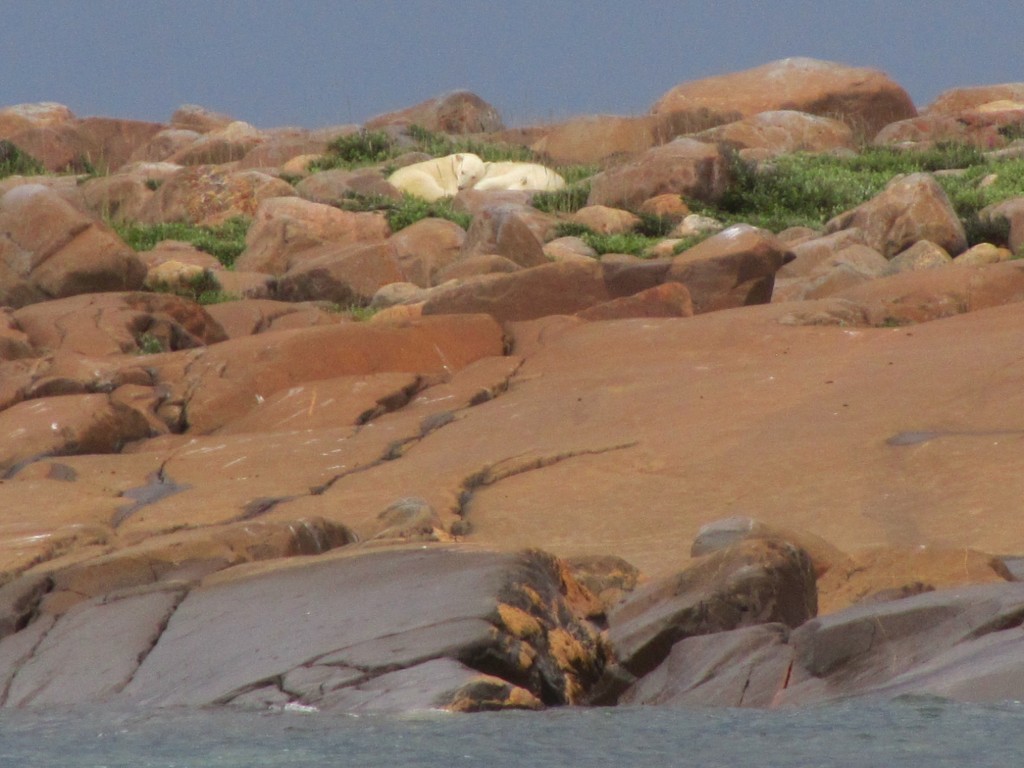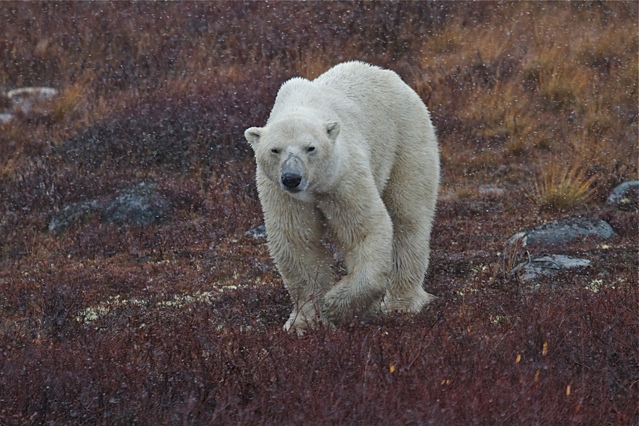Churchill Ice Report and Summer Preview
The Hudson Bay is packed solid with thick ice and seems to be supporting a healthy seal-feeding season for polar bears. Extreme cold and stormy weather has been pervasive throughout the region this year and should lead to a extended hunting season for bears on the ice surface. Here is the link of the most recent Hudson Bay ice chart from Environment Canada Ice Survey.
Polynas up in the Hudson Straits harbor herds of beluga whales waiting for ice to break up and allow for their spring migration. These open water leads are formed either by warmer currents upwelling from below and keeping an area adjacent to the sea ice unfrozen or from currents and wind conditions that move through the region. They are vital to the survival of narwhals and beluga whales that do not migrate south in the winter.
When the belugas arrive in early summer, almost 2,500 animals will inhabit the coastal waters near Churchill including all the rivers and inlets there. At high tide, the Churchill River becomes a calving estuary stretching nearly eight kilometers up river. These relatively warm waters will make for a calm calving process and infancy. When newborn, calves are a darker almost slate gray. This color, opposing the milky white of the adult stage, is thought to be a subtle camouflage trait for the darker water they inhabit. As they grow and become whiter, the color is camouflage as well when living up north amongst the sea ice of near color. Since adults are more alert and more adept at detecting and eluding predators. Young grey -colored whales enjoy the guardianship and protection of their mothers…swimming tightly in their slipstream.
The summer in Churchill is a daily reveal of mystery and treasure hidden in the willows and wildflowers of the tundra and the pre- cambrian rolling boulders of the coastal barrier. Each foray into the wild can produce anything the imagination can bring to mind. A beluga whale carcass nestled in the sea grass out at Halfway Point, a polar bear wandering through the boreal forest looking for some eggs from nesting birds, or even a black wolf lumbering in and out of boggy areas near the town weir out along Goose Creek road. As the summer moves forward, polar bears can be spotted along the coast as they arrive from the ice floes in the bay. Each day, each season produces something new and unexpected. Nothing compares to Churchill in the summer….the pace slows down and time seems to come to a standstill. Of course if you like the chance seeing 40 or more polar bears in a day fall might be the time to visit as well. Natural Habitat Adventures has a wide variety of trips that fit into your travel plans.
Polar bears in the mist
The greatest memories of adventure tours seem to be the ones that aren’t predictable or pre -determined by set activity schedules. They happen unexpectedly and usually involve some trepidation. With the Churchill Arctic Summer season approaching I’m reminiscing about a memorable day on the Hudson Bay coast.
I had a feeling of angst that August morning years ago as we boarded the polar rover docked at the platform just outside the Great White Bear shop 20 kilometers outside Churchill, MB. After an extraordinary 38 hour train journey from Winnipeg to Churchill with a group of a dozen avid Arctic explorers, we were all anxious to get out, “on the land” as they say in the north. The rover journey to Halfway Point was one I had taken nearly a hundred times before..but this day something felt strange. The air was cool and misty fog floated from the bogs up and over the tundra toward the coast. My mind kept wandering.

Halfway Point..a view down to the beach and location of the beluga skeleton in the grass.
Our drive through the Churchill Wildlife Management Area (CWMA) was soothing as the rocking movement of the rover blended with the slight hint of salt air wafting up from the Hudson Bay to lull everyone into a calm state of mind. Although the group had spent minimal time on land the past couple of days, everyone seemed content to know that soon we would be on foot trudging over the precambrian shield rocks and incredible wildflowers and berries of various northern plants. A barbecue overlooking the Hudson Bay with a cool Summer breeze off the water to dissuade mosquitoes….life doesn’t get any better up north…unless a polar bear happens to walk by.
On board my co-guide and Ornithology expert Bonnie Chartier spotted various birds in the willows and across the landscape. Birders in the group enjoyed witnessing rare species interacting in the northern web of life. With the fog sometimes making identification difficult, the enjoyment came from just observing. The excitement was infectious to all.
We crept closer to the point overlooking the turbulent Hudson Bay. I explained that we would be hiking down through a rocky outcropping which opened onto a beach strewn with kelp. There was a skeleton from a beluga whale carcass at the far end of the beach nestled up in the sea grass. Another Natural Habitat group led by myself and long -time colleague Mike Bruscia had been lucky enough to discover it nearly a year before while exploring the beach. Now the hope was to find it again…though we would never make it that far.
Our rover driver, John Sinclair, who this story really is about, was a quiet unassuming local who did whatever he needed to provide for his family. A great guy and a friend of mine. As John maneuvered the machine into a spot up on the rise above the bay, everyone was anxious to disembark and feel the tundra under their feet. I still had a sense of hesitation but couldn’t pin point why….just a feeling.
John lowered the heavy aluminum-grated stairway and the group gathered around the rover’s enormous rear wheel for some safety rules. We headed down the gravelly road toward the beach. Usually the rover driver would stay behind on the hike to get the barbecue going for the guests return and I alone, wielding a 12 gauge shotgun filled with cracker shells and a couple of slugs would escort the group along the beach. But as I quickly realized, John was walking quietly and..well..unassuming next to me.
The mist was now a ground – fog as the group moved tentatively along and we were soon about a hundred yards from the rover. John told me, “he was going back to the rover”…well at least that’s what I thought he said. What he actually said in a tone somewhere between a whisper and a mumble was, ” I think we all should go back to the rover”. At the time I was talking with a traveler so the moment didn’t sink in as it did later. I remember looking up at John and seeing the calm in his eyes…though later on I realized it was a heightened calm that only someone who lives year – round amongst the polar bears has…someone who knows to never let his guard down when in the bear’s territory. A breeze separated the curtain of fog just enough for us to see a massive male bear about another hundred yards from us..slowly walking, as calm as John, right toward us all. We quickly signaled the rest of the group that was somewhat spread out and we all as one unit retreated intently though slowly back toward the machine waiting silently to rescue us. This was really the only time in the 12 years of guiding Summer trips I thought I might actually have to shoot a polar bear. If it wasn’t for John Sinclair’s innate sense of the land and bears I surely would have….hopefully with success.
Years later John Sinclair died in a snow mobile accident on the outskirts of Churchill in late winter. I will always remember him for his cool and relaxed personality as well as the day he possibly saved many lives. Whenever I think of him I first remember that afternoon at Halfway Point.











